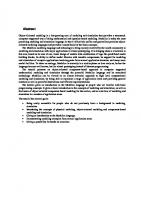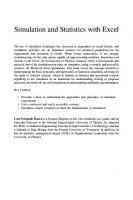An Introduction to Modeling and Simulation with (Python(P))DEVS 9781728132839
297 25 5MB
english Pages [15] Year 2019
Recommend Papers

- Author / Uploaded
- Y. V. Tendeloo
- H. Vangheluwe and R. Franceschini
File loading please wait...
Citation preview
Proceedings of the 2019 Winter Simulation Conference N. Mustafee, K.-H.G. Bae, S. Lazarova-Molnar, M. Rabe, C. Szabo, P. Haas, and Y.-J. Son, eds.
AN INTRODUCTION TO MODELING AND SIMULATION WITH (PYTHON(P))DEVS
Yentl Van Tendeloo Hans Vangheluwe
Romain Franceschini
Department of Mathematics and Computer Science University of Antwerp Middelheimlaan 1 Antwerp, 2020, BELGIUM
University of Corsica Pasquale Paoli UMR CNRS 6134 Campus Grimaldi Corte, 20250, FRANCE
ABSTRACT Discrete Event System Specification (DEVS) is a popular formalism for modeling complex dynamic systems using a discrete-event abstraction. At this abstraction level, a timed sequence of “events” input to a system cause instantaneous changes to the state of the system. Main advantages of DEVS are its rigorous formal definition, and its support for modular composition. This updated tutorial from the WSC’18 tutorial “Discrete Event System Specification Modeling and Simulation” introduces the Classic DEVS formalism in a bottom-up fashion, using a traffic light example. The syntax and operational semantics of Atomic (i.e., non-hierarchical) models are introduced first. Coupled (i.e., hierarchical) models are introduced to structure and couple Atomic models. We continue to actual applications of DEVS, e.g. in performance analysis of queueing systems. All examples are presented with the tool PythonPDEVS, though this introduction is applicable to others. We conclude with further reading on DEVS theory, DEVS variants, and DEVS tools. 1
INTRODUCTION
Discrete Event System Specification (DEVS) (Zeigler et al. 2019) is a popular formalism for modeling complex dynamic systems using a discrete-event abstraction. At this abstraction level, a timed sequence of pertinent “events” input to a system cause instantaneous changes to the state of the system. These events can be generated externally (i.e., by another model) or internally (i.e., by the model itself due to timeouts). The next state of the system is defined based on the previous state of the system and the event. Between events, the state does not change, resulting in a piecewise constant state trajectory. Simulation kernels must only consider states at which events occur, skipping over all intermediate points in time. This is in contrast with discrete time models, where time is incremented with a fixed increment, and only at these times the state is updated. Discrete event models have the advantage that their time granularity can become (theoretically) unbounded, whereas time granularity is fixed in discrete time models. Nonetheless, the added complexity makes it unsuited for systems that naturally have a fixed time step. This tutorial provides an introductory text to DEVS (often referred to as Classic DEVS) using a simple model in the domain of traffic lights. This paper is a revised version of a similar paper accompanying our tutorial at the 2018 Winter Simulation Conference Proceedings (Van Tendeloo and Vangheluwe 2018). We start from a simple autonomous traffic light, incrementally extended up to a traffic light with policeman inter action. Each increment serves to introduce a new component of the DEVS formalism and the corresponding (informal) semantics. It is accompanied by an example implementation in PythonPDEVS (Van Tendeloo and Vangheluwe 2016), though the concepts are equally applicable to other tools. We start with atomic (i.e., non-hierarchical) models in Section 2, and introduce coupled (i.e., hierarchical) models in Section 3. Section 4 moves away from the traffic light example and presents a more complex
978-1-7281-3283-9/19/$31.00 ©2019 IEEE
1415
Authorized licensed use limited to: Universitaetsbibl Rostock. Downloaded on May 16,2023 at 15:11:00 UTC from IEEE Xplore. Restrictions apply.
Van Tendeloo, Vangheluwe, and Franceschini
Figure 1: Trace of the autonomous traffic light.
Figure 2: Model generating trace in Figure 1.
problem. Section 5 presents several directions of further reading on DEVS. Finally, Section 6 summarizes the tutorial. 2
ATOMIC DEVS MODELS
We commence our explanation of DEVS with the atomic models. As their name suggests, atomic models are the indivisible building blocks of a model. Throughout this section, we build up the complete formal specification of an atomic model, introducing new concepts as they become required. In each intermediate step, we show and explain the concepts we introduce, how they are present in the running example, and how this influences the semantics. Next to a full specification of each increment, PythonPDEVS example code is shown to illustrate the close match. 2.1 Autonomous Model The simplest form of a traffic light is an autonomous traffic light. Looking at it from outside, we expect to see a trace similar to that of Figure 1. Visually, Figure 2 presents an intuitive representation of a model that could generate this kind of trace. Trying to formally describe Figure 2, we distinguish these elements: 1.
State Set (S : x ^ S O The most obvious aspect of the traffic light is the state it is in, which is indicated by the three different colors it can have. These states are sequential: the traffic light can only be in one of these states at the same time. The set of states is not limited to enumeration style as presented here but can contain an arbitrary number of attributes. 2. Time Advance (ta : S ^ R++~) For each of the states just defined, we notice the timeout in them. Clearly, some states take longer to process than others. For example, whereas we will stay in green and red a relatively long time, the time in the yellow state is only brief. This function needs to be defined for each and every element of the state set, and needs to deterministically return a duration. The duration can be any positive real number, including zero and infinity. A negative time is disallowed, as this would require simulation to go back in time. DEVS allows a time advance of exactly zero, even though this is impossible in real life. Two use cases for this exist: the delay might be very small and irrelevant to the problem we are modeling, or the state is an artificial state, without any real-world equivalent (e.g., as part of a design pattern). DEVS does not consider time bases, despite the use of seconds in our visualization. Simulation time is just a real number, and the interpretation given to 1416 Authorized licensed use limited to: Universitaetsbibl Rostock. Downloaded on May 16,2023 at 15:11:00 UTC from IEEE Xplore. Restrictions apply.
Van Tendeloo, Vangheluwe, and Franceschini from pypdevs.DEVS import *
(Si qinit 7&int7ta) S = {Green, Yellow , Red } qinit = (Green, 0.0) 8int = {Green ^ Yellow , Yellow ^ Red , Red ^ Green} ta = {Green ^ 57, Yellow ^ 3, Red ^ 60} Figure 3: Autonomous atomic DEVS.
class TrafficLightAutonomous(AtomicDEVS): def __init (self): AtomicDEVS.__init__(self, "Light") self.state, self.elapsed = ("Green", 0.0) def intTransition(self): state = self.state return {"Red": "Green", "Yellow": "Red", "Green": "Yellow"}[state] def timeAdvance(self): state = self.state return {"Red": 60, "Yellow": 3, "Green": 57}[state]
Figure 4: PythonPDEVS representation of Figure 3.
it is up to the user. Whether these units indicate seconds, years, or even n seconds, is completely up to the users, as long as it remains fixed throughout the simulation. 3. Internal Transition (8int : S ^ S) With the states and timeouts defined, the final part is the definition of which is the next state from a given state. This is the job of the internal transition function, which gives the next state for each state. As it is a function, every state has at most one next state, preventing any possible ambiguity. The function does not necessarily have to be total, nor injective: some states might not have a next state (i.e., if the time advance was specified as + » ), and some states have the same state as a next state. Up to now, only the internal transition function is described as changing the state. Therefore, it is not allowed for other functions (e.g., time advance) to modify the state: their state access is read-only. 4. Initial Total State (q init : Q) w e also need to define the initial state of the system. while this is not present in the original specification of the DEVS formalism by Zeigler et al. (2019), we include it here as it is a vital element of the model. But instead of being an “initial sequential state” (sinit ), it is an “initial total state” (qinit ). This means that we do not only select the initial state of the system, but also define how long we are already in this state. Elapsed time is, therefore, added to the definition of the initial total state, to allow for more flexibility when modeling a system. To the simulator, it will seem as if the model has already been in the initial state for some time. Total states are specified as follows: Q = {(s ,e)|s e S,0 < e < ta(s)}. w e describe the model in Figure 2 as the 4-tuple defined in Figure 3. Figure 4 presents the example specification as PythonPDEVS code. For this simple formalism, we define the semantics as in Algorithm 1. The model is initialized with simulation time set to 0, and the state set to the initial state (i.e., G r e e n ). Simulation updates the time with the return value of the time advance function, and executes the internal transition function on the current state to get the new state. This is repeated until simulation terminates. 2.2 Autonomous Model With Output Recall that DEVS is a modular formalism, with only the atomic model having access to its internal state. This raises a problem for our traffic light: others have no access to the current state (i.e., its color).
1417 Authorized licensed use limited to: Universitaetsbibl Rostock. Downloaded on May 16,2023 at 15:11:00 UTC from IEEE Xplore. Restrictions apply.
Van Tendeloo, Vangheluwe, and Franceschini
Algorithm 1 Simulation pseudo-code for autonomous models. time ^ 0 current s ta te ^ initial sta te last-time








![An Introduction to Atmospheric Modeling [Colo. State Univ. Course, AT604]](https://ebin.pub/img/200x200/an-introduction-to-atmospheric-modeling-colo-state-univ-course-at604.jpg)
